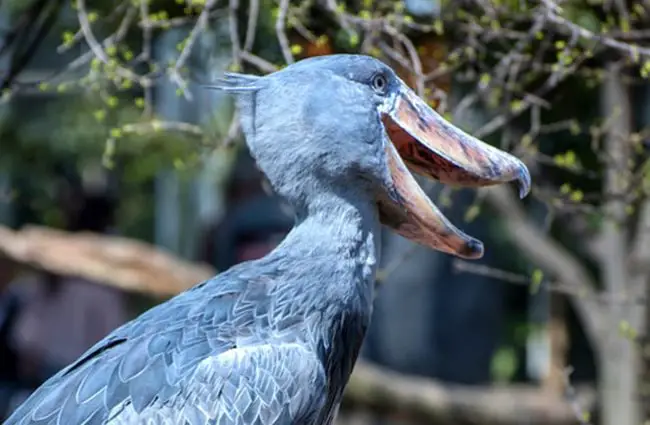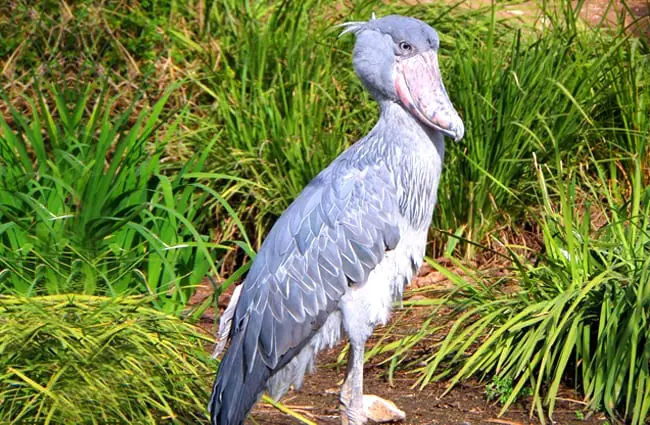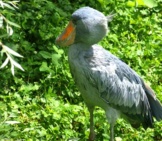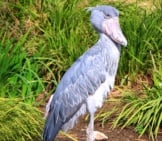Shoebills are large birds with uniquely shaped beaks. They are sometimes called “whaleheads,” again, for their odd bill. Their namesake “shoebill” is large, and very closely resembles a shoe! While these birds are called shoebill storks, they are actually members of the taxonomic order Pelecaniformes. This makes them relatives of pelicans, anhingas, gannets, and more. Read on to learn about the shoebill stork.
Description of the Shoebill Stork
These birds are quite large, and can easily stand over 4 feet tall! Their most distinguishing characteristic is their distinctive bill, which is shaped almost exactly like a shoe! The bill has a sharp, curved tip and sharp edges to kill and decapitate prey. Not only is the beak deadly, sharp, and oddly shape, but it is also quite large at up to 9.4 inches long! Their feathers are slate grey, and they have long legs ending in large feet.
Interesting Facts About the Shoebill Stork
These predators are surprisingly fierce and vicious while dispatching prey. While they naturally draw attention because of their unusual appearance, there are a number of fun facts that many people don’t know about these interesting birds!
- Patient Predator – These birds utilize those long legs while hunting by wading into the waters of marshes and ponds. They can stand incredibly still for long periods of time. So still, in fact, that prey doesn’t even realize they’re there! When a tasty frog or eel swims by, the shoebill lunges forward and snaps its sharp bill around its meal.
- Cool Excrement – No we don’t mean they have cool looking poop, we mean their feces is literally cool! Under the hot African sun, these birds will do just about anything to cool off. One effective cooling method these birds employ is defecating on their own feet and legs. The blood circulating through that area is cooled by their poop, and reduces their overall body temperature.
- After a While, Crocodile – When we say these birds are impressive predators, we mean it! They are carnivorous, and have been known to feed on lungfish, eels, snakes, frogs, rats, and lizards. They will also prey on crocodiles! Well, baby crocodiles (they’re big, but not that big!).
Habitat of the Shoebill Stork
This species has a relatively restricted range and habitat. They are successful at hunting in aquatic environments, and most often live in freshwater swamps and marshes. They live in swamps with mixed papyrus plants and other vegetation.
Virtually every wetland that this species can be found in has papyrus, typha, and phragmites plants. They are occasionally spotted in flooded agricultural plantations and rice fields.
Distribution of the Shoebill Stork
These birds are found exclusively in the tropical area of central Africa. They can be found in the southern portions of Sudan, the eastern Congo, Uganda, Rwanda, western Tanzania, and the northern portions of Zambia. They have also been sighted in a number of nearby locations within Africa, but the vast majority of the population lives in central Africa.
Diet of the Shoebill Stork
Shoebills are carnivorous birds, and primarily feed on fish and other aquatic creatures. Their favorite food is lungfish, and they also frequently feed on Senegal bichir, tilapia, catfish, snakes, young crocodiles, frogs, and Nile monitors. They will also sometimes feed on rats, turtles, small birds, snails, and other small mammals.
Their primary method of hunting prey is ambush, and they will stand still for hours waiting for a likely meal to wander too close. Once the prey is within range, they lunge forward and use their sharp bill to decapitate it.
Shoebill Stork and Human Interaction
Humans have had a negative impact on this species, and they are listed as Vulnerable by the IUCN. It is believed that the total population is less than 10,000 individuals, possibly around 8,000.
Hunting plays a large role in the decline of this species. Both adults and eggs are collected for food. Habitat destruction is also extremely detrimental to this species. They rely heavily on their marsh habitats, and cannot survive when these areas are destroyed.
Domestication
These birds have not been domesticated in any way.
Does the Shoebill Stork Make a Good Pet
Shoebills are quite large, making them difficult to house. In most places it is illegal to own a shoebill stork as a pet, and they are threatened with extinction, which makes each individual important for the survival of the species.
Shoebill Stork Care
In a zoological setting these birds must be provided with plenty of enclosure space, and an appropriate wading pool. They are primarily terrestrial, so providing perches and flying area is less necessary than in some other avian species. As predators, they are provided with a varied diet, usually consisting of different types of fish, small mammals, and more.
Behavior of the Shoebill Stork
Most of the time, these birds are seen standing stock-still waiting for prey to wander nearby. They move relatively slowly, wading in shallow waters, and through dense vegetation searching for food. they are quite shy, and it is not unusual for a pair to abandon a nest when disturbed by humans. These birds are primarily solitary, and only interact with one another for the purpose of breeding.
Reproduction of the Shoebill Stork
Pairs of shoebills defend their nests and surrounding territories aggressively. Unlike many other members of the Pelecaniformes order, they do not nest in groups or colonies. Both parents work to clear an area and build a nest.
The female normally lays 2 eggs, and incubates them for about 30 days before they hatch. The eggs hatch a few days apart, and the youngest sibling usually does not survive. At about 105 days old, the chick will begin to fly, and they will be fully independent in another 30 days or so.











![Red Angus Closeup of a beautiful Red Angus cowPhoto by: U.S. Department of Agriculture [pubic domain]https://creativecommons.org/licenses/by/2.0/](https://animals.net/wp-content/uploads/2020/03/Red-Angus-4-238x178.jpg)












![Red Angus Closeup of a beautiful Red Angus cowPhoto by: U.S. Department of Agriculture [pubic domain]https://creativecommons.org/licenses/by/2.0/](https://animals.net/wp-content/uploads/2020/03/Red-Angus-4-100x75.jpg)

